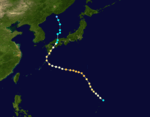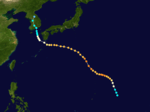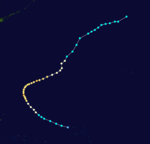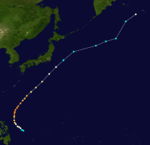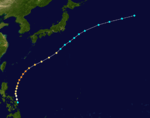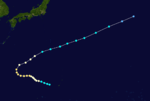| 1946 Pacific typhoon season |
|---|
|
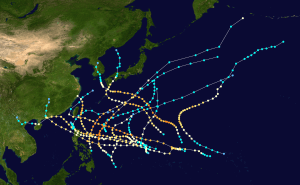
Season summary map |
| Seasonal boundaries |
|---|
| First system formed |
March 27, 1946 |
|---|
| Last system dissipated |
November 20, 1946 |
|---|
| Strongest storm |
|---|
|
|
| Name |
Lilly |
|---|
| • Maximum winds |
220 km/h (140 mph)
(1-minute sustained) |
|---|
| • Lowest pressure |
927 hPa (mbar) |
|---|
|
|
| Seasonal statistics |
|---|
| Total storms |
15 |
|---|
| Typhoons |
10 |
|---|
| Total fatalities |
Unknown |
|---|
| Total damage |
Unknown |
|---|
| Related articles |
|---|
|
|
|
The 1946 Pacific typhoon season has no official bounds; it ran year-round in 1946, but most tropical cyclones tend to form in the northwestern Pacific Ocean between June and December. These dates conventionally delimit the period of each year when most tropical cyclones form in the northwestern Pacific Ocean.
The scope of this article is limited to the Pacific Ocean, north of the equator and west of the international date line. Storms that form east of the date line and north of the equator are called hurricanes; see 1946 Pacific hurricane season. Tropical Storms formed in the entire west pacific basin were assigned a name by the Joint Typhoon Warning Center. Tropical depressions in this basin have the "W" suffix added to their number. Tropical depressions that enter or form in the Philippine area of responsibility are assigned a name by the Philippine Atmospheric, Geophysical and Astronomical Services Administration or PAGASA. This can often result in the same storm having two names.
Storms
Typhoon Barbara
|
Category 3 typhoon (SSHWS) |
|
|
| Duration |
March 27 – April 7 |
|---|
| Peak intensity |
185 km/h (115 mph) (1-min) 965 hPa (mbar) |
|---|
Typhoon Barbara formed on March 27, and moved west. It strengthened briefly to a category three with 115 mph winds. But shortly after, it began to weaken. Typhoon Barbara curved northward and then westward, in turn hitting the Philippines as a category one. After making landfall, it curved back to the east and continued to weaken until April 7, when it dissipated.
Typhoon Charlotte
|
Category 1 typhoon (SSHWS) |
|
|
| Duration |
May 11 – May 17 |
|---|
| Peak intensity |
150 km/h (90 mph) (1-min) 973 hPa (mbar) |
|---|
Typhoon Dolly
|
Category 3 typhoon (SSHWS) |
|
|
| Duration |
June 17 – June 23 |
|---|
| Peak intensity |
205 km/h (125 mph) (1-min) 942 hPa (mbar) |
|---|
On June 17, Typhoon Dolly formed. It moved northwestward, only to strengthen. After passing by the Philippines, it reached its maximum intensity of 125 mph, a strong major hurricane. It rounded around Taiwan and made landfall on China's shoreline. It dissipated hours after on June 23.
Tropical Storm Elinor
|
Tropical storm (SSHWS) |
|
|
| Duration |
June 23 – June 25 |
|---|
| Peak intensity |
95 km/h (60 mph) (1-min) 986 hPa (mbar) |
|---|
Typhoon Ginny
|
Category 1 typhoon (SSHWS) |
|
|
| Duration |
June 30 – July 2 |
|---|
| Peak intensity |
150 km/h (90 mph) (1-min) 971 hPa (mbar) |
|---|
Typhoon Ingrid
|
Category 4 typhoon (SSHWS) |
|
|
| Duration |
July 12 – July 20 |
|---|
| Peak intensity |
220 km/h (140 mph) (1-min) 944 hPa (mbar) |
|---|
Tropical Storm Ingrid formed July 12, immediately moving west. After strengthening, it briefly became a category four on July 15. It weakened to a category two and struck the northern part of the Philippines. Ingrid retained its strength until it hit China. Right after it made landfall in China, it moved north and dissipated on July 20.
Typhoon Janie
|
Category 3 typhoon (SSHWS) |
|
|
| Duration |
July 23 – July 31 |
|---|
| Peak intensity |
185 km/h (115 mph) (1-min) 946 hPa (mbar) |
|---|
Janie formed on July 23. It moved northwest and then curved west. It was then that she became a major hurricane with 115 mph winds. After heading westward for a while, Janie began curving the opposite direction. But that was short-lived; it began moving northwest and struck southern Japan. Janie traveled over the island and dissipated near Russia's coast on July 31.
Typhoon Lilly
|
Category 4 typhoon (SSHWS) |
|
|
| Duration |
August 10 – August 21 |
|---|
| Peak intensity |
230 km/h (145 mph) (1-min) 927 hPa (mbar) |
|---|
On August 10, a disturbance managed to organize itself enough to be designated Tropical Storm Lilly. It moved in a generally northwest direction while intensifying at a moderate pace-becoming Typhoon Lilly shortly after its formation. Before Lilly moved over cold waters, it attained a peak intensity of 145 mph. It narrowly missed Japan's shoreline as a category two before striking Korea as a moderate tropical storm. Lilly dissipated on August 21, after eleven days of the traveling of the western Pacific Ocean.
Tropical Storm Maggie
|
Tropical storm (SSHWS) |
|
|
| Duration |
August 22 – August 27 |
|---|
| Peak intensity |
110 km/h (70 mph) (1-min) 980 hPa (mbar) |
|---|
Typhoon Opal
|
Category 3 typhoon (SSHWS) |
|
|
| Duration |
September 7 – September 14 |
|---|
| Peak intensity |
185 km/h (115 mph) (1-min) 962 hPa (mbar) |
|---|
Typhoon Priscilla
|
Category 3 typhoon (SSHWS) |
|
|
| Duration |
September 8 – September 19 |
|---|
| Peak intensity |
185 km/h (115 mph) (1-min) 945 hPa (mbar) |
|---|
Typhoon Querida
|
Category 4 typhoon (SSHWS) |
|
|
| Duration |
September 18 – September 27 |
|---|
| Peak intensity |
220 km/h (140 mph) (1-min) 937 hPa (mbar) |
|---|
On September 25, the typhoon passed over southern Taiwan with a minimum pressure of 937 mbar (27.68 inHg), producing wind gusts of 198 km/h (123 mph). Across the island, Querida destroyed 373,748 houses, killed 154 people, and injured another 618. The storm also wrecked 564,263 ha (1,394,320 acres) of crops and forestry, killing 28,448 animals.[1]
Typhoon Alma
|
Category 4 typhoon (SSHWS) |
|
|
| Duration |
October 18 – October 26 |
|---|
| Peak intensity |
220 km/h (140 mph) (1-min) 929 hPa (mbar) |
|---|
Typhoon Betty
|
Category 4 typhoon (SSHWS) |
|
|
| Duration |
November 5 – November 11 |
|---|
| Peak intensity |
220 km/h (140 mph) (1-min) 938 hPa (mbar) |
|---|
Typhoon Dianne
|
Category 2 typhoon (SSHWS) |
|
|
| Duration |
November 13 – November 20 |
|---|
| Peak intensity |
175 km/h (110 mph) (1-min) 968 hPa (mbar) |
|---|
Storm names
- Barbara
- Charlotte
- Dolly
- Elinor
- Ginny
- Ingrid
- Janie
- Lilly
|
- Maggie
- Opal
- Priscilla
- Querida
- Alma
- Betty
- Dianne
|
See also
References
- ↑ Jean Kan Hsieh; Chiao-min Hsieh (September 1955). Typhoons on the Southeastern Coast of China and Formosa (PDF) (Report). Massachusetts Institute of Technology. p. 48. Retrieved August 16, 2016.
External links






